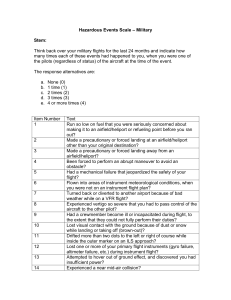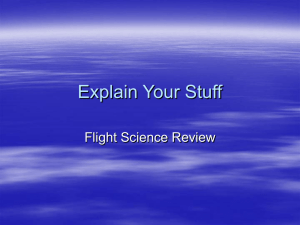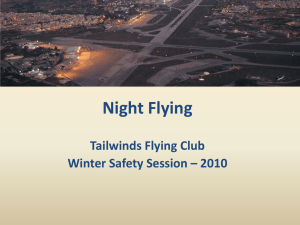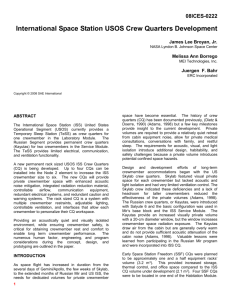training syllabus - St. Charles Flying Service
advertisement
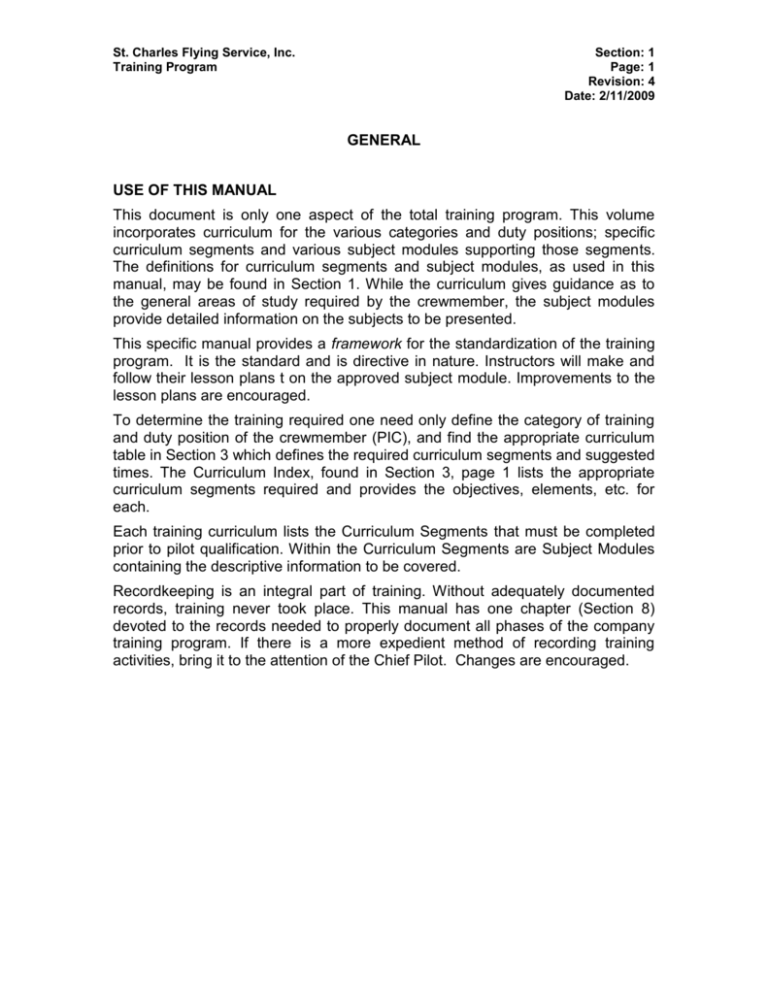
St. Charles Flying Service, Inc. Training Program Section: 1 Page: 1 Revision: 4 Date: 2/11/2009 GENERAL USE OF THIS MANUAL This document is only one aspect of the total training program. This volume incorporates curriculum for the various categories and duty positions; specific curriculum segments and various subject modules supporting those segments. The definitions for curriculum segments and subject modules, as used in this manual, may be found in Section 1. While the curriculum gives guidance as to the general areas of study required by the crewmember, the subject modules provide detailed information on the subjects to be presented. This specific manual provides a framework for the standardization of the training program. It is the standard and is directive in nature. Instructors will make and follow their lesson plans t on the approved subject module. Improvements to the lesson plans are encouraged. To determine the training required one need only define the category of training and duty position of the crewmember (PIC), and find the appropriate curriculum table in Section 3 which defines the required curriculum segments and suggested times. The Curriculum Index, found in Section 3, page 1 lists the appropriate curriculum segments required and provides the objectives, elements, etc. for each. Each training curriculum lists the Curriculum Segments that must be completed prior to pilot qualification. Within the Curriculum Segments are Subject Modules containing the descriptive information to be covered. Recordkeeping is an integral part of training. Without adequately documented records, training never took place. This manual has one chapter (Section 8) devoted to the records needed to properly document all phases of the company training program. If there is a more expedient method of recording training activities, bring it to the attention of the Chief Pilot. Changes are encouraged. St. Charles Flying Service, Inc. Training Program Section: 1 Page: 2 Revision: 4 Date: 2/11/2009 GENERAL INFORMATION REGULATIONS Under the provisions of FAR 135, Subpart H, it is the responsibility of the operator to develop a training program in order to enhance safety and standardization. This manual, when implemented, fulfills the provision of a training program as required under FAR 135.341: Pilot and Flight Attendant Crewmember Training Programs; recurrent training as required under FAR 135.351: Recurrent Training; and of course, FAR 135.323: Training Program: General. Under the provisions of FAR 135.343: Crewmember Initial and Recurrent Training, there is a requirement that, “No certificate holder may use a person, nor may any person serve, as a crewmember in operations under this part unless that crewmember has completed the appropriate initial or recurrent training phase of the training program appropriate to the type of operation in which the crewmember is to serve since the beginning of the 12th calendar month before that service.” Note, however, the provisions of FAR 135.323(b), "Whenever a crewmember who is required to take recurrent training under this subpart completes the training in the calendar month before, or the calendar month after, the month in which that training is required, the crewmember is considered to have completed it in the calendar month in which it was required." There is a similar provision in FAR 135.505(a) which states that, "No certificate holder may use any crewmember or person to perform any of the job functions . . . unless that person has satisfactorily completed the certificate holder's FAAapproved initial or recurrent hazardous materials training program within the past 24 months. However, note the provisions of FAR. 135.505(d), which states that, “A person who satisfactorily completes recurrent hazardous materials training in the calendar month before, or the calendar month after, the month in which the recurrent training is due, is considered to have taken that training during the month in which it is due.” Also note that this training manual refers directly to the approved training maneuver guide outlined in Section 9 of this manual. One purpose of this training program is to provide information and impart skills to pilots leading to the checks required under FAR 135.293, .297 or .299. Testing and checking determines whether learning has occurred. In that light, oral tests will be administered throughout the training program. St. Charles Flying Service, Inc. Training Program Section: 1 Page: 3 Revision: 4 Date: 2/11/2009 PREREQUISITES To be eligible for training, the pilot must meet requirements of section: 1 pages 10 and 11 in the Operations manual for St. Charles Flying Service Inc. DFJA167D. APPLICABILITY This document sets forth the standards and requirements for the established and maintenance of an approved training program for crew members, check airmen, flight instructors and other applicable operations personnel employed by or under contract to St. Charles Flying Service Inc. TRAINING OBJECTIVE At the conclusion of any category training curriculum, the individual involved will be able to successfully demonstrate his knowledge of the regulations, polices, and procedures applicable to the specific block of instruction by oral testing. In relation to flight checks, the pilot will be able to fly the aircraft with the successful outcome of the maneuver never in doubt. TRAINING SYLLABUS The ground training syllabus as outlined under the various category curricula provides an ordered listing of the required ground training subjects including emergency training for each aircraft type. Flight training is incorporated within that same category curriculum. FACILITIES Training will be conducted in the training room at St Charles Flying Service Inc. The room can comfortably seat eight students and is equipped with tables, chairs and white board. Other training aids include: an overhead projector, DVD player, pc with Internet connection an Elite PI-135 BATD. COURSEWARE 1. A listing of training materials made available to each student can be found in Section: Training Materials. 2. Specific lesson plans are not contained in this manual. All instructors will formulate a lesson plan prior to instruction. 3. A reference library is maintained by St Charles Flying Service, Inc. A list of material used in the training program and contained in the library are listed in Section: Training Materials St. Charles Flying Service, Inc. Training Program Section: 1 Page: 4 Revision: 4 Date: 2/11/2009 QUALIFICATION REQUIREMENTS No person will be assigned duties as a crewmember until the following requirements have been completed: 1. The crewmember must meet or exceed the requirements contained in FAR 135.243 and 247. qualification 2. In accordance with FAR 135.331, each crewmember will undergo emergency training on the make and model aircraft assigned to fly. 3. The crewmember must have successfully completed either a course on the recognition of and transportation and handling of Hazardous Materials in accordance with FAR 135.505. 4. Ground training, in accordance with FAR 135.345, must have been successfully completed. 5. The crewmember must have successfully passed an oral or written examination within the past twelve (12) calendar months conducted by an authorized check airman or FAA inspector as stipulated in FAR 135.293(a). 6. In accordance with paragraph (b) of FAR 135.293, the crewmember must successfully complete a flight test administered in the aircraft to be flown by an authorized check airman or FAA inspector. 7. In order to function as a pilot in command it is necessary that an enroute qualification check be conducted within the preceding twelve (12) months as prescribed in FAR 135.299. 8. If applicable, the pilot must have successfully passed a proficiency check conducted under the provisions of FAR 135.297. 9. Candidates for company instructor pilots or check airmen must meet the requirements of FAR 135.338, 339 & 340. St. Charles Flying Service, Inc. Training Program Section: 1 Page: 5 Revision: 4 Date: 2/11/2009 PROGRAMMED FLIGHT TRAINING HOURS - REDUCTION A flight crewmember will complete a flight training curriculum segment by successfully accomplishing each training event and the specified number of training hours, however these hours may be reduced (see below for specific criteria). Flight crewmembers are then required to successfully meet the requirements specified in the Qualification Segment. If a crewmember fails to meet any of the qualification requirements because of a lack in flight proficiency, the crewmember must be returned to training status. After additional or retraining, an instructor recommendation is required for reaccomplishing the unsatisfactory qualification requirement. A flight crewmember may successfully complete a training curriculum segment without completing the specified number of training hours provided all of the following are met (ref: FAA Order 8900.1 3-1230 Paragraph G): 1. The crewmember successfully completes all of the training events required by the curriculum segment. 2. An instructor recommends that testing/checking be conducted before completion of the specified number of training hours. THE RECOMMENDATION MUST BE DOCUMENTED on form TR7 in section 8 page 11. 3. The crewmember satisfactorily completes the qualification curriculum segment requirements. If a flight crewmember fails to meet the qualification curriculum segment requirements because of lack of flight proficiency, the crewmember must complete all training hours specified. The crewmember must then be recommended by an instructor before reaccomplishing the failed qualification requirements. St. Charles Flying Service, Inc. Training Program Section: 1 Page: 6 Revision: 4 Date: 2/11/2009 CREDIT FOR PREVIOUS GROUND TRAINING It is recognized that in some cases a “new-hire” flight crewmember may have recently completed subject areas which apply to an aircraft which the crewmember will be qualified to operate. This previous training will be a result of having been qualified (within the last twelve months) with another certificated operator of that particular aircraft In a situation such as this, certain ground training subject modules may be granted credit for previous training. In order to take advantage of this “credit” certain documentation MUST be on file in the crewmember’s record file. Acceptable training “credit” will be within the same make and model. Variations within a series and/or installed equipment (navigation systems, etc.) must be evaluated and knowledge determined to be satisfactory. Supporting documentation will consist of the following: 1. Copies of training received from a certificated Air Carrier’s approved FAR 135 training program, including an FAA form 84103, Proficiency Check record (within the previous twelve calendar months). 2. Copies of training received from a training center such as Flight Safety or Simuflite (within the previous twelve calendar months). Training credit will be granted only with supporting documentation in the crewmember’s file. Training in each subject area for which credit is granted will consist of a quiz or review to determine the extent of the crewmember’s knowledge and instruction as necessary in any area of knowledge determined to be deficient Credit for previous training may be granted as follows: 1. Basic Indoctrination: Airman Specific Modules only. 2. General Emergency: Situation Modules only. 3. Aircraft Ground: Systems Modules only. 4. Instructor/Check Airman: Ground Training only St. Charles Flying Service, Inc. Training Program Section: 1 Page: 7 Revision: 4 Date: 2/11/2009 INSTRUCTORS AND CHECK AIRMEN No person may serve as a flight instructor or check airman in the training program for a particular type aircraft unless that person: 1. Holds the airman certificate and ratings that must be held to serve as a pilot in command for that type of operation. 2. Has satisfactorily completed the appropriate training phases for the aircraft, including recurrent training, which would qualify the individual to serve as a pilot in command. 3. Has satisfactorily completed the appropriate proficiency or competency checks required to serve as a pilot in command 4. Has satisfactorily completed the applicable training requirements of FAR 135.339 or 135.340 as applicable. 5. Holds a current Class I or Class II medical certificate. 6. In the case a check airman, has been approved by the Administrator for the airman duties involved 7. Meet pilot qualification recent experience of FAR135.247. Ground training will be conducted at the direction of the Chief Pilot or his designated representative. The Chief Pilot will be responsible for administering all tests be they written or oral. St. Charles Flying Service, Inc. Training Program Section: 1 Page: 8 Revision: 4 Date: 2/11/2009 DEFINITIONS The following terms are used throughout this training manual and are defined as follows: Training Program: A system of instruction which includes curricula, facilities, instructors, check airmen, courseware, instructional delivery methods, and testing and checking procedures. This system must satisfy the training program requirements of FAR Part 135 and ensure that each crewmember remains adequately trained for each aircraft, duty position, and kind of operation in which the person serves. Curriculum: A complete training agenda specific to an aircraft type and a crewmember duty position. Each curriculum consists of several curriculum segments. Curriculum Segment: An integral phase of a curriculum which can be separately evaluated and individually approved but by itself does not qualify a person for a crewmember duty position. Each curriculum segment consists of one or more training modules. Training Module: An integral part of a curriculum segment which contains descriptive information, elements, or events which relate to a specific subject. For example, a ground training curriculum segment must have training modules (composed of "elements") pertaining to aircraft systems (hydraulic, pneumatic, electrical, etc.). As another example, a flight training curriculum segment must have training modules (composed of "events") pertaining to normal, abnormal, and emergency procedures. A training module includes the outline, appropriate courseware, and the instructional delivery methods. It is usually completed in a single training session. Courseware: Instructional material developed for each curriculum. This is information in lesson plans, instructor guides, computer software programs, audiovisual programs, workbooks, aircraft operating manuals, and handouts. Courseware must accurately reflect curriculum requirements, be effectively organized, and properly integrate with instructional delivery methods. Instructional Delivery Methods: Methodology for conveying information to a student. For example, this may include lectures, demonstrations, audiovisual presentations, home study assignments, workshops, and drills. Training devices, simulators, aircraft, and computer work stations are also considered instructional delivery methods. St. Charles Flying Service, Inc. Training Program Section: 1 Page: 9 Revision: 4 Date: 2/11/2009 Eligibility Period: Three calendar months (the calendar month before the "training/checking month," the "training/checking month," and the calendar month after the "training/checking" month). During this period a crewmember or aircraft dispatcher must receive recurrent training, a flight check, or a competency check, to remain in a qualified status. Training or checking completed during the eligibility period, is considered to be completed during the "training/checking month."
